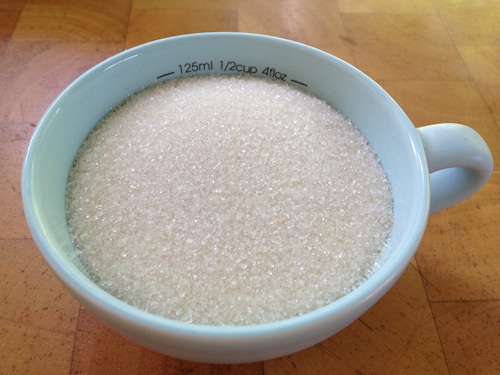Every week, the average American consumes two to three pounds of sugar. Quick math, and that translates to approximately 150 pounds a year, most of which comes in the form of empty calories. You know, those empty calories that come from refined and processed sugar that is devoid of the vitamins, miners, enzymes and amino acids that are essential to helping the body metabolize sugar. (Or, maybe you don’t know).
When most of us think of sugar, we think of the white stuff that appears in our sugar casters, and which we use in our coffee and tea, sprinkle over oatmeal, and use as a key ingredient in our homemade baked goodies.
What isn’t so obvious to us, are the many other ways added sugars appear in our diets. It appears on food labels as corn syrup, dextrose, corn sweetener, maltose, malt syrup, glucose, molasses, sucrose, syrup, and high fructose corn syrup. These ingredients are commonly found in candies, cakes, cookies, and soft drinks, but are also found in packaged food favorites such as macaroni and cheese, bread and yogurt.
The ills of sugar have been top of mind for many of us. We constantly hear how sugar is bad for our health, and is the cause of many health problems, including obesity, cardiovascular disease and depression. But, even with all the news out there, I was still a bit confused about what all the fuss is about sugar. I’m not a diabetic, and I haven’t had to watch my intake for any health reasons . . . but I do have kids, and I continually hear about cutting sugar in their diets. So, I guess it is time to explore.
The problem with consuming so much sugar is that the constant influx of sugar into the bloodstream upsets the body’s blood-sugar balance. This triggers the release of insulin, which the body uses to keep blood-sugar at a constant and safe level. It is important to realize that Insulin also promotes the storage of fat. So, when we consume high levels of sugar, we’re opening the door for rapid weight gain.
Further, the glycemic index (a measure of how a given food affects blood-glucose levels), of foods is important. The lower the rating, the slower the absorption and digestion process. This process provides a more gradual, healthier infusion of sugars into the bloodstream. On the other hand, a high rating means that blood-glucose levels are increased quickly. This stimulates the pancreas to secrete insulin to drop blood-sugar levels. These rapid fluctuations of blood-sugar levels are not healthy because of the stress they place on the body.
Recently, the American Heart Association released recommendations for specific levels and limits on the consumption of sugars.
The statement says that most women should consume no more than 100 calories (about 25 grams) of added sugars per day. Most men should consume no more than 150 calories (about 37.5 grams) each day. That’s about six teaspoons of added sugar a day for women and nine for men.
For more information, visit the American Heart Association website.
How it is Produced
Most conventional table sugars are either cane sugar or beet sugar or a combination of the two. Though the sugar in the bowl is identical in chemical structure and function in the kitchen, an ever-increasing number of consumers are concerned about the ways the sugars are produced. To begin, consumers should consider just what’s in the bag (or bottle). Then consider how it’s made.
Unrefined sugar is made from sugar cane juice that is released by pressing sugar cane stalks. It is different from refined sugar in that it is typically 50% less processed and therefore contains slightly more molasses than refined sugar.
The most widely used sweeteners are conventional white sugar and high fructose corn syrup.
Raw and minimally processed sweeteners generally contain more nutrition than highly processed alternatives including refined sugars and high fructose corn syrup. Organic sweeteners have the added benefit of being grown and processed in a way that is not only healthier for us but for the environment as well. As explained by Karen Stevenson, consumer marketing manager for Wholesome Sweeteners,the category leader in Fair Trade Certified, organic and natural sugars, syrups, nectars and honeys produced from nature’s best resources, Technically, “USDA Organic” means the cane is cultivated and milled without chemicals and to USDA NOP Standards (prohibiting synthetic chemicals). Similarly, “natural” remains undefined, but generally indicates extremely limited use of inorganic chemicals; and in the vernacular, “refined” describes a highly intensive factory-based manufacturing process (often including synthetic chemicals).”
Stevenson continued, explaining the process:
“Sugar cane is an extra-large member of the grass family that thrives naturally in the tropics. Cane is one of nature’s best photosynthesizers–converting up to 2% of sunlight into life-sustaining sugar in the form of carbohydrates. Organically grown cane is grown as nature intended: simply, with only sunlight, rain and healthy soils. Conventionally grown cane is subjected to myriad synthetic chemicals.
Once harvested, the cane must be milled within 24 hours or the cane begins to rot and the precious cane juice spoils. Milling is simple: the cane is crushed, its juice is collected, the juice is filtered, and then evaporated (just as you would reduce a sauce on the stove–the juice is heated and the water boils off, with concentrates the cane juice). At a certain point in the evaporation process, the sucrose in the cane juice begins crystallizing. The cane juice is spun in a turbine which separates the sugar crystals from its nutrient-rich byproduct, molasses, which lends a golden color to each sugar granule. The sugar is dried, the molasses is bottled and off it goes. But to where?
(Note: At this point, Wholesome’s sugars are packaged and sent to your local grocer.)
For conventionally refined cane sugars, this is just the first step. The conventionally processed golden granules are shipped to a sugar refinery where they are liquefied, filtered (often either through bone char or with the aid of synthetic chemicals) and crystallized. Then the entire process is repeated again. And again. And again (etc.), until the sugar is bright white, sharply sweet (without the nuances of the cane’s natural molasses) and the granules are absolutely consistent in size.
Some conventional sugars go through as many at 32 steps at the refinery. Then the sugar is packaged and sent to your local grocer.
Sugar beets, on the other hand, grows well in more temperate zones as root vegetables. In 2008, the first genetically modified (“GM”) sugar beets were planted in the US. Since then, the percentage of GM sugar beets has grown exponentially. Sugar beet refining is a complicated process that involves slicing the beets thin, rinsing them, treating the slices with chemicals to draw the starches out, then chemically treating the starches to stabilize them and convert them into sugars. (Formaldehyde is one chemical preferred by many refiners.) Once converted, the juice is evaporated and crystallized.”
Therefore, when choosing a sugar, unrefined raw sugar is the best choice because it contains minerals and nutrients that are stripped from the refined white sugar. To heed the advice to avoid sugar may seem a bit drastic to many of us – and quite hard to do. The best advice offered is to be aware of your choices. Eat whole foods offering natural-occurring sugars and cut down on processed foods, preparing meals from scratch so that you can monitor and know, exactly what amount of sugar is in the food you eat.
There is a broad spectrum of healthy, natural sweeteners to choose from, and they vary in degrees of processing and nutrition.






